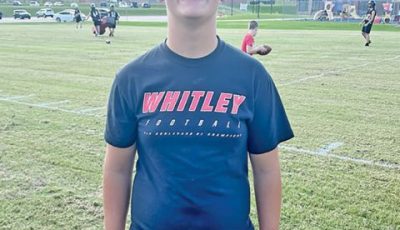School safety expert meets with Corbin Schools officials

Jon R. Akers, on far right, walks through Corbin High School with school administrators during a visit Monday. He is Executive Director of the Kentucky Center for School Safety.
Practice lockdown drills.
Communicate with your community.
Invest in more in-school police officers.
That was the advice of Jon R. Akers, Executive Director of the Kentucky Center for School Safety, to administrators with the Corbin Independent School system Monday.
Akers met with school leaders for a discussion session following recent shootings in Marshall County, KY and Parkland, Florida.
“I don’t have all the answers to all the questions, but I’ve learned a lot over the years,” Akers told the group of about 15 principals, assistant principals, school board members and other administrators.
Following the discussion, which took place in the Corbin High School media Center, Akers toured the school to helped advise on improved response for possible active shooter situations.
Akers first noted that the shootings have caused a wave of ill-advised attempts to “get some type of attention through threats” against schools, mostly on the Internet through social media. Minors, and adults, have been arrested and charged with such activity in Knox, Laurel, Whitley and Clay Counties in the past week.
“I’m very conservative when it comes to children and trying to correct misbehavior,” Akers said. “If you don’t have a meaningful consequence you are not going to change these kids behavior. It’s as simple as that.”
Akers said students guilty of making such threats needed to serve time in jail, and their parents needed to be required to pay restitution for the cost of investigations.
After spending 17 year as a school principal, including a stint at Dunbar High School in Lexington, Akers said that there are all sorts of ideas about how to better secure schools. All of them, however, need to be done in conjunction and with the advice of educators.
“We have a tsunami of parents who want to buy wands and metal detector walkthrough thresholds,” Akers said.
“If you were a kid that was trying to bring something bad into the school, would you come through the front door, or would you go around to one of the 44 other doors where [you] might have access?”
“A friend of mine from Maryland said metal detectors keep the honest kids from bringing guns to school. The dishonest kids will find a way to get them in there.”
A good portion of the discussion focused on metal detectors. Corbin attorney Shane Romines, through a video shared on Facebook, offered $20,000 to help the school system purchase metal detectors and an additional $5,000 for other items like tazers or firearms. Donations from others bring the total to over $50,000. The school system partially accepted the offer Tuesday.
Corbin Independent School Systems Superintendent Dave Cox asked Akers what the best use of funds aimed at improving school safety would be.
“Buy a cop. Buy a cop,” he said emphatically.
Cox noted that Corbin Schools currently has two School Resource Officers — trained police officers who are employed by the city of Corbin and paid through a grant program — but that grant funding would end in May.
Akers said metal detectors are useful in some instances, but also present challenges. He suggested that if operated, they needed to be used by trained law enforcement personnel, which can be quite expensive. He also said that they rarely help school officials find firearms, but instead lead to a wave of confiscation of other items like pocketknives.
“When you start wanding kids, you are going to find a whole lot of pocket knives … You are going to find some really good collectors items there,” he said. “You are going to find those and then you are going to have a whole lot of parents knocking on your door wanting those knives back.”
Akers said installing metal detectors and searching student’s bags daily can also greatly slow down the process of getting kids into a school in the morning. Many times, they will be waiting outside, again making them a prime target for a shooter.
“You get five buses that show up and 300 kids wanting to get in. If you are a shooter, you are going to pick them off outside.”
Cox noted that CHS periodically randomly checks student book bags when they come into the school, but does not do it daily.
Akers said that some schools will use metal detectors in the same way … using them as needed or randomly, but not daily.
Ideas such as arming teachers, hiring “school marshals” or keeping firearms under lock and key in the school weren’t one Akers said were desirable, for a variety of reasons.
He pointed out that no student has yet been shot, during an active shooter situation, while barricaded in a classroom.
“On these kinds of things, you play the percentages,” Akers said.
In the most recent shooting in Parkland, the suspect in the killings pulled a fire alarm in order to trick students into coming out in the common areas. Akers said that, in almost every instance, that’s when school shooters are able to do all their damage, during times when large numbers of students are in hallways or cafeterias. He suggested that school districts may want to look at having a delayed response to fire alarms since most modern schools aren’t particularly likely to have large scale fires since they are built with so many materials that simply will not burn and have adequate sprinkler systems. He suggested an administrator see if there really is a fire first before evacuating.
In the end, Akers said communication with the community is key. Parents and guardians need to be heavily involved in the lives of their children and monitor online activity.
The community, he said, needs to communicate with school officials and law enforcement about any possible threat. And everything needs to be checked out.
“You need to investigate, with law enforcement, every threat that comes down,” Akers said. “If you don’t they are going to kill you on social media.”








